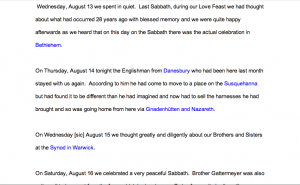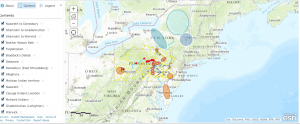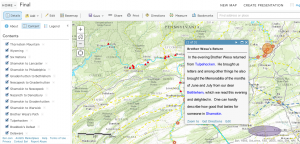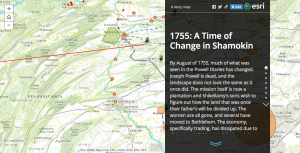In the beginning of the semester, Professor Faull assigned each student in our Digital Humanities class a page from the Powell Diary to transcribe and convert into an online English transcription. Although the close reading and transcribing of the Powell Diary into an online English edition helped me to understand the literal meaning of the text I was given, I never was able to completely grasp the full picture of the events that occurred throughout the whole Powell Diary. However, a few weeks ago, Professor Faull along with Professor Jackacki introduced our class to a new field of Digital Humanities, referred to as mapping. Through the information that each student was able to extrapolate from their respective pages in the Powell Diary, our class was able to collaborate and create a comprehensive data sheet of both the people and the places that were mentioned throughout the Powell Diary. This data sheet, also known as Prosopography, that our class collaborated to create not only showed us the names of the people and places in the Powell Diary, but it also showed us their importance in the story along with their interactions with others in the Diary. After gathering all of the necessary information needed for the mapping project, Professor Faull brought in another digital humanities expert that helped to show the class how to use the information from the Prosopography to create a story map of our own pages of the Powell Diary through the use of the acrGIS application. After creating several layers, adding text and information, and publishing my work into a story journal format, I was able to create my first arcGIS story map. With this map, I was able to successfully retell the events that occurred in the second page of the Powell Diary and also show the extent of Shamokin’s power under the leadership of figures such as Brother Powell and Shikellamy. After looking at all of the work my classmates and I had completed that week, I was able to gain a better understanding of the information in my page of the Powell Diary and was also able to gain new insights on the other pages of the Powell Diary through the arcGIS story maps that each of my classmates had also created. As a result, when it came time for my partner Duke and I to decide on what our final project should be, it was an easy decision to do another mapping project.
The first thing that Duke and I did was meet with Professor Faull in order to make a decision on what texts we should use for our mapping project. Although we wanted to do something that was similar to the Powell Diary, neither of us had any ideas in the beginning. However, after sitting down with Professor Faull, she gave us the idea to do our mapping project on the last twenty pages of the Shamokin Diary (Rösler Diary). My partner Duke and I thought that this was a great idea and knew that with the mapping of the end of the Rösler Diary, we would be able to show whether or not Shamokin was still significant as compared to what it was during the time of the Powell Diary, and also show the effect that the beginning of the French and Indian War played on the people around Shamokin.

The first step that Duke and I took was divvying up the work. Since arcGIS is not an application that allows two people to work on the same project at once, we decided to split the Rösler Diary in half with Duke taking the last ten pages of the Rösler Diary (October) and myself taking the first ten pages of the Rösler Diary (August). After dividing the work into two, I started my project by color coating the place names that were mentioned in my half of the diary. After color-coating the words, I placed all of the place names and dates from the diary into a new Google data sheet in order to start my prosopography. Since the purpose of an arcGIS map is to tell a story, I knew that putting all of the names and dates into the Prosopography was simply not enough. As a result, I added a new column to my Prosopography, Importance in the Story. Through close reading of Professor Faull’s translated text, I was able to extract more information about the importance of specific people and places in my half of the Rösler Diary. After creating a detailed Prosopography, I had enough information to create my acrGIS map.

The first step that I took in order to get a good base for my map was to take the layers that Professor Faull had put in her humanities arcGIS map, and add them to my map. Some of the layers I used from Professor Faull’s map included the Native American Trails, Moravian Missions, Colonial Forts, and the Susquehanna River. Following the addition of the base layers for my map, I added the locations of all of the places that were in my Prosopography. In addition, I also added the paths and trails that the people mentioned in the text were taking in my section of the Rösler Diary.

After I had a map that included the locations, paths, and base layers that were necessary to tell my half of the Rösler Diary, I added information of each of the locations in the map, making sure to include pictures, text from the Rösler Diary, and information from outside sources to supplement. After much time and effort, I finally had enough information to add Duke’s layers in order to complete our map. Finally after much collaboration, trial and error, and editing my partner Duke saved the map and published it online as a story map journal for everyone to see.


After publishing our arcGIS map, Duke and I added several slides of text to help explain the complex situations and events that occurred during our sections in the Rösler Diary. Collectively, Duke and I were very happy with the work that we had completed. Not only were we able to show Shamokin’s fleeting importance in 1755, but we were also able to show how much things had changed since the Powell Diary due to the beginning of the French and Indian War.
Since I joined the digital humanities class a week late, Professor Faull did not have me write the first blog post that the rest of our class had completed. However, when we first met with one another, Professor Faull and I had a long conversation about the importance of digital artifacts. Although at the time I thought the only advantage of digital artifacts was to make original documents easier to access, looking back at it I now know just how little I knew about digital humanities at the time. Through this class, I had the privilege to work with experts in the field of digital humanities and learn that the field of digital humanities is a new study that is gaining more influence and importance every day. Through the use of digital artifacts, people across the world are now having the capability to gain access to years of information on cutting-edge subjects and texts that people previously would not been able to get their hands on. Although it was difficult to work as a group because arcGIS is an application that can only be accessed one at a time, the experience that Duke and I had from our previous mapping project gave us the tools to succeed with our collaborative effort. In addition, although it was at times hard to tell the story of the last twenty pages of the Rösler Diary through the mapping of arcGIS, with the guidance of Professor Faull, Duke and I were able to put everything together and create a very comprehensive story map.